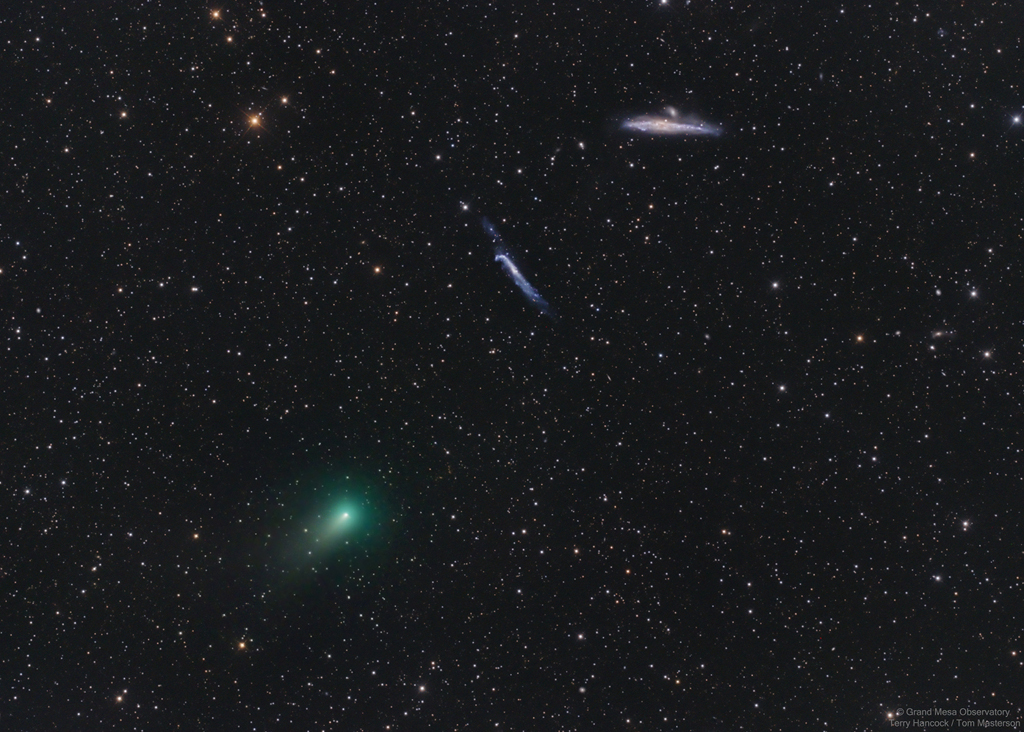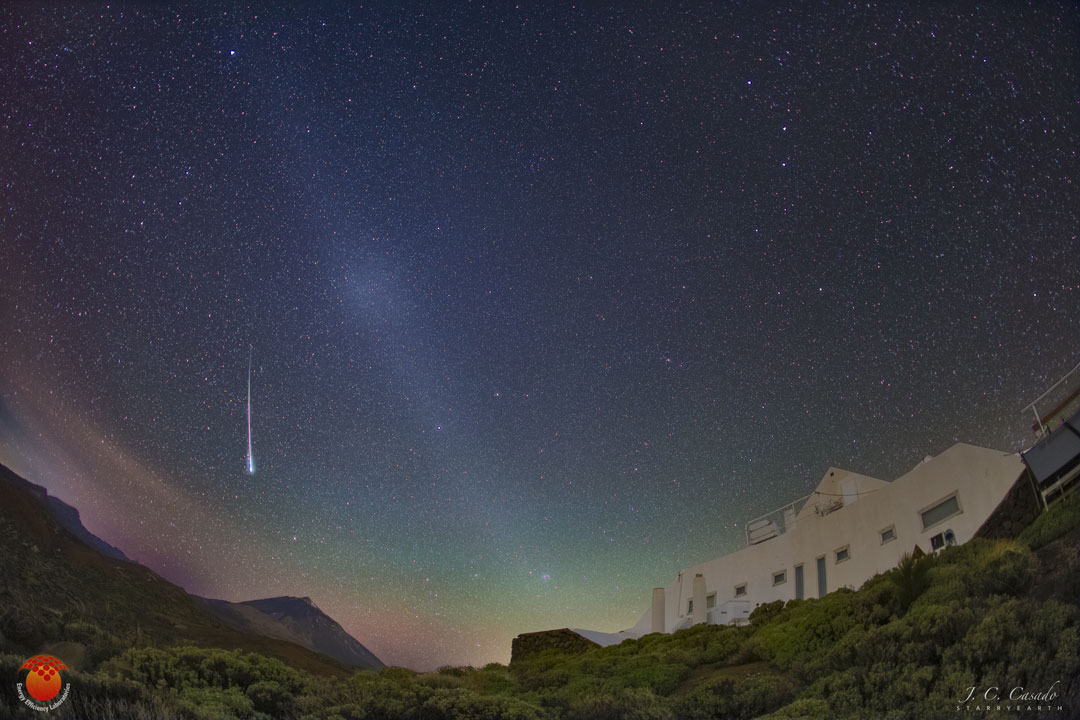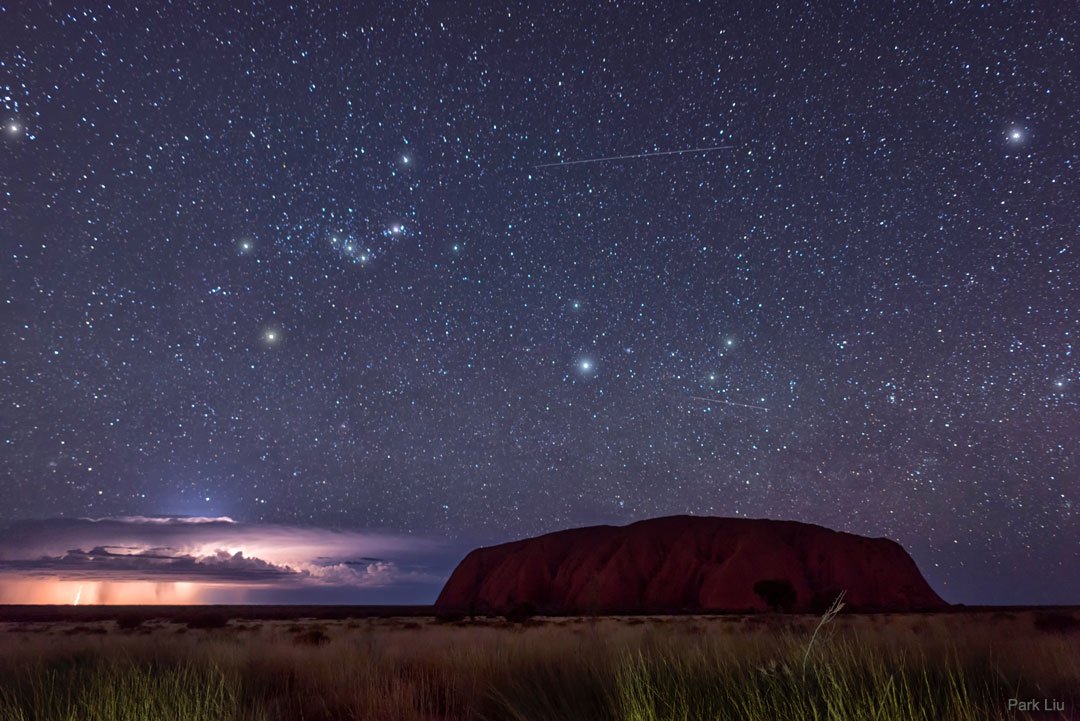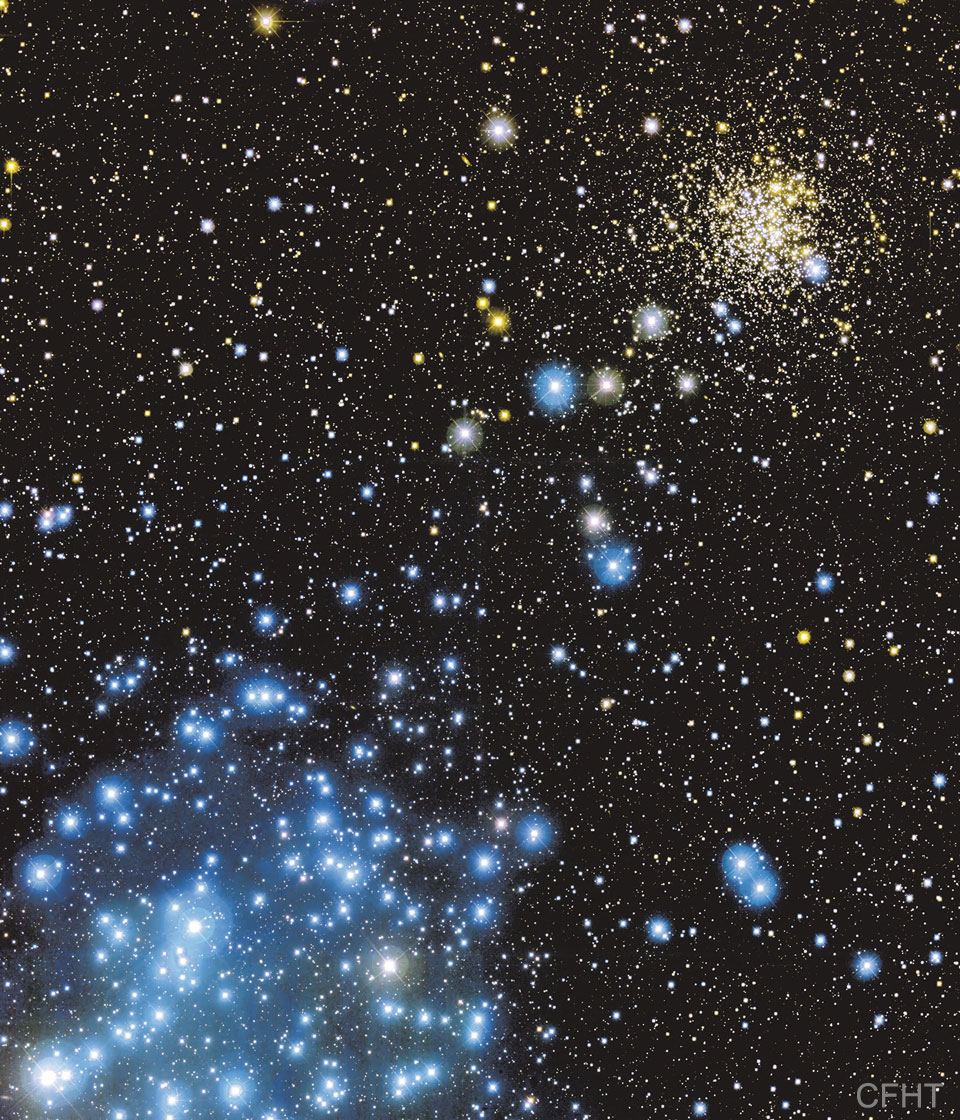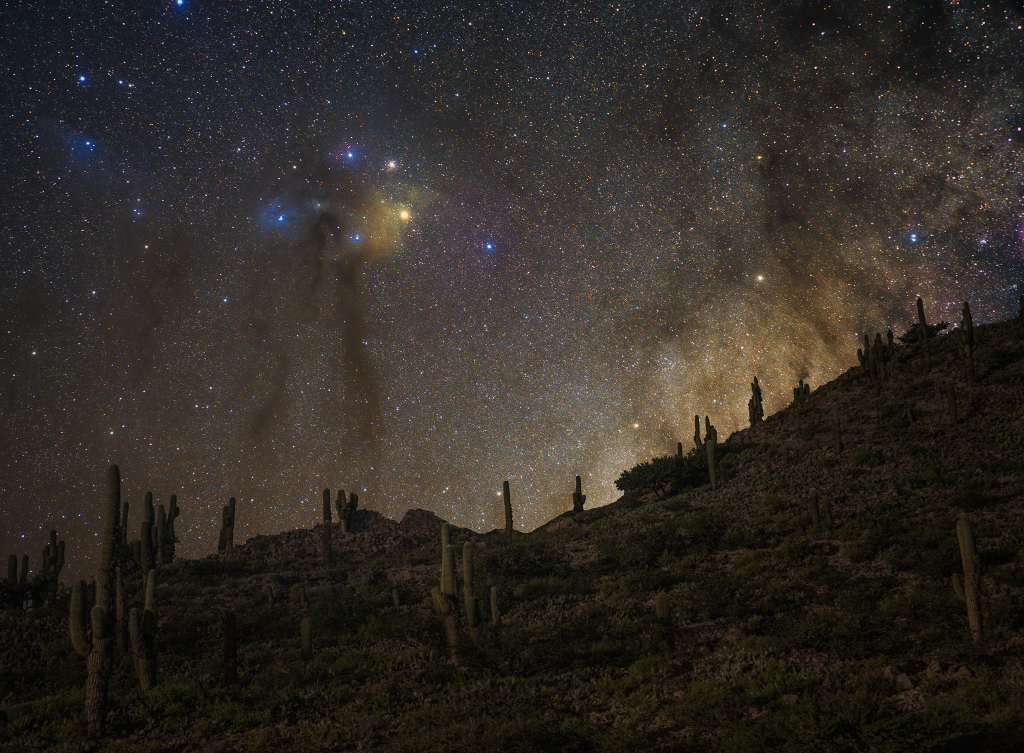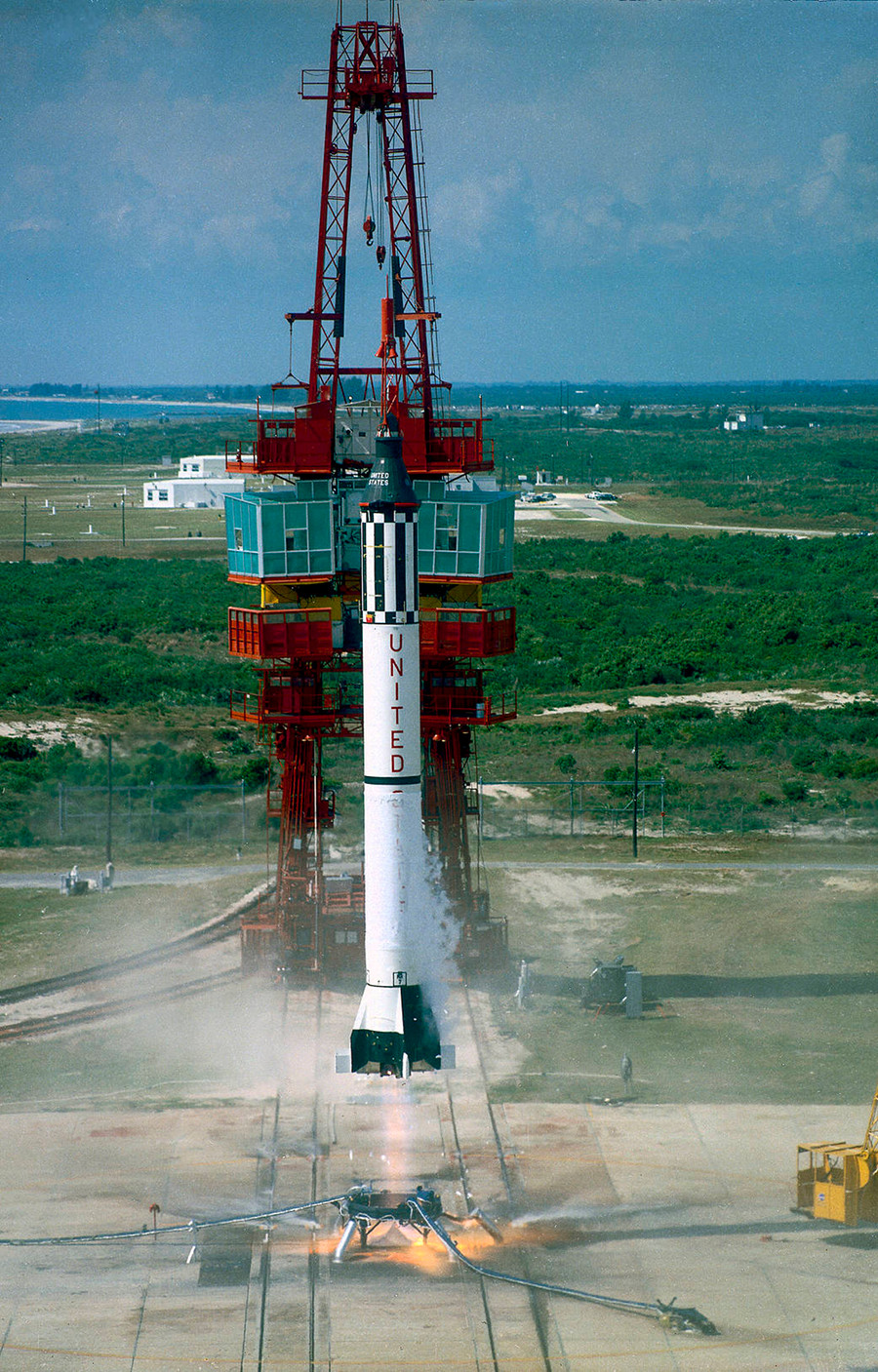Nombre total de pages vues
13/05/2021
I-PHONE ASTUCES - Arrêter la musique avec le minuteur
ASTRONOMY - The Comet, the Whale, and the Hockey Stick
2021 May 13
Image Credit & Copyright: Grand Mesa Observatory, Terry Hancock / Tom Masterson
Explanation: Closest to the Sun on March 1, and closest to planet Earth on April 23, this Comet ATLAS (C/2020 R4) shows a faint greenish coma and short tail in this pretty, telescopic field of view. Captured at its position on May 5, the comet was within the boundaries of northern constellation Canes Venatici (the Hunting Dogs), and near the line-of-sight to intriguing background galaxies popularly known as the Whale and the Hockey Stick. Cetacean in appearance but Milky Way sized, NGC 4631 is a spiral galaxy seen edge-on at the top right, some 25 million light-years away. NGC 4656/7 sports the bent-stick shape of interacting galaxies below and left of NGC 4631. In fact, the distortions and mingling trails of gas detected at other wavelengths suggest the cosmic Whale and Hockey Stick have had close encounters with each other in their distant past. Outbound and only about 7 light-minutes from Earth this Comet ATLAS should revisit the inner solar system in just under 1,000 years.
12/05/2021
I-PHONE ASTUCES - Utiliser Google Maps SANS Connexion
ASTRONOMY - A Meteor and the Gegenschein
2021 May 12
Image Credit: J.C. Casado, StarryEarth, EELabs, TWAN
Explanation: Is the night sky darkest in the direction opposite the Sun? No. In fact, a rarely discernable faint glow known as the gegenschein (German for "counter glow") can be seen 180 degrees around from the Sun in an extremely dark sky. The gegenschein is sunlight back-scattered off small interplanetary dust particles. These dust particles are millimeter sized splinters from asteroids and orbit in the ecliptic plane of the planets. Pictured here from last March is one of the more spectacular pictures of the gegenschein yet taken. The deep exposure of an extremely dark sky over Teide Observatory in Spain's Canary Islands shows the gegenschein as part of extended zodiacal light. Notable background objects include a bright meteor (on the left), the Big Dipper (top right), and Polaris (far right). The meteor nearly points toward Mount Teide, Spain's highest mountain, while the Pyramid solar laboratory is visible on the right. During the day, a phenomenon like the gegenschein called the glory can be seen in reflecting air or clouds opposite the Sun from an airplane.
11/05/2021
I-PHONE ASTUCES - Prendre une photo avec le bouton du volume
ASTRONOMY - Lightning and Orion Beyond Uluru
2021 May 11
Image Credit & Copyright: Park Liu
Explanation: What's happening behind Uluru? A United Nations World Heritage Site, Uluru is an extraordinary 350-meter high mountain in central Australia that rises sharply from nearly flat surroundings. Composed of sandstone, Uluru has slowly formed over the past 300 million years as softer rock eroded away. In the background of the featured image taken in mid-May, a raging thunderstorm is visible. Far behind both Uluru and the thunderstorm is a star-filled sky highlighted by the constellation of Orion. The Uluru region has been a home to humans for over 22,000 years. Local indigenous people have long noted that when the stars that compose the modern constellation of Orion first appear in the night sky, a hot season involving lightning storms will soon be arriving.
10/05/2021
ASTRONOMY - Star Clusters M35 and NGC 2158
2021 May 10
Image Credit & Copyright: CFHT, Coelum, MegaCam, J.-C. Cuillandre (CFHT) & G. A. Anselmi (Coelum)
Explanation: Clusters of stars can be near or far, young or old, diffuse or compact. The featured image shows two quite contrasting open star clusters in the same field. M35, on the lower left, is relatively nearby at 2800 light years distant, relatively young at 150 million years old, and relatively diffuse, with about 2500 stars spread out over a volume 30 light years across. Bright blue stars frequently distinguish younger open clusters like M35. Contrastingly, NGC 2158, on the upper right, is four times more distant than M35, over 10 times older, and much more compact. NGC 2158's bright blue stars have self-destructed, leaving cluster light to be dominated by older and yellower stars. In general, open star clusters are found in the plane of our Milky Way Galaxy, and contain anywhere from 100 to 10,000 stars -- all of which formed at nearly the same time. Both open clusters M35 and NGC 2158 can be found together with a small telescope toward the constellation of the Twins (Gemini).
09/05/2021
PRATIQUE/POURQUOI - Pourquoi la Louisiane se nomme t-elle ainsi ?
08/05/2021
ASTRONOMY - Deepscape at Yacoraite
2021 May 8
Image Credit & Copyright: Franco Meconi
Explanation: In this evocative night scene a dusty central Milky Way rises over the ancient Andean archaeological site of Yacoraite in northwestern Argentina. The denizens of planet Earth reaching skyward are the large Argentine saguaro cactus currently native to the arid region. The unusual yellow-hued reflection nebula above is created by dust scattering starlight around red giant star Antares. Alpha star of the constellation Scorpius, Antares is over 500 light-years distant. Next to it bright blue Rho Ophiuchi is embedded in more typical dusty bluish reflection nebulae though. The deep night skyscape was created from a series of background exposures of the rising stars made while tracking the sky, and a foreground exposure of the landscape made with the camera and lens fixed on the tripod. In combination they produce the single stunning image and reveal a range of brightness and color that your eye can't quite perceive on its own.
07/05/2021
ASTRONOMY - Mercury-Redstone 3 Launch
2021 May 7
Image Credit: NASA
Explanation: Sixty years ago, near the dawn of the space age, NASA controllers "lit the candle" and sent Mercury astronaut Alan Shepard arcing into space atop a Redstone rocket. His cramped space capsule was dubbed Freedom 7. Broadcast live to a global television audience, the historic Mercury-Redstone 3 (MR-3) spacecraft was launched from Cape Canaveral Florida at 9:34 a.m. Eastern Time on May 5, 1961. The flight of Freedom 7, the first space flight by an American, followed less than a month after the first human venture into space by Soviet Cosmonaut Yuri Gagarin. The 15 minute sub-orbital flight achieved an altitude of 116 miles and a maximum speed of 5,134 miles per hour. As Shepard looked back near the peak of Freedom 7's trajectory, he could see the outlines of the west coast of Florida, Lake Okeechobe in central Florida, the Gulf of Mexico, and the Bahamas. Shepard would later view planet Earth from a more distant perspective and walk on the Moon as commander of the Apollo 14 mission.
SANTé/MEDECINE - Une nouvelle arme contre le cancer - (7/8) - Un traitement sans résistance ni toxicité
Un autre grand avantage de cette technologie est qu’elle ne repose sur aucun médicament. Les cellules cancéreuses ne peuvent donc pas dévelo...

-
2022 September 26 All the Water on Planet Earth Illustration Credit: Jack Cook, Adam Nieman, Woods Hole Oceanographic Institution ; Data ...
-
2025 February 17 SpaceX Rocket Launch Plume over California Image Credit & Copyright: Martin LaMontagne Explanation: What's happe...

